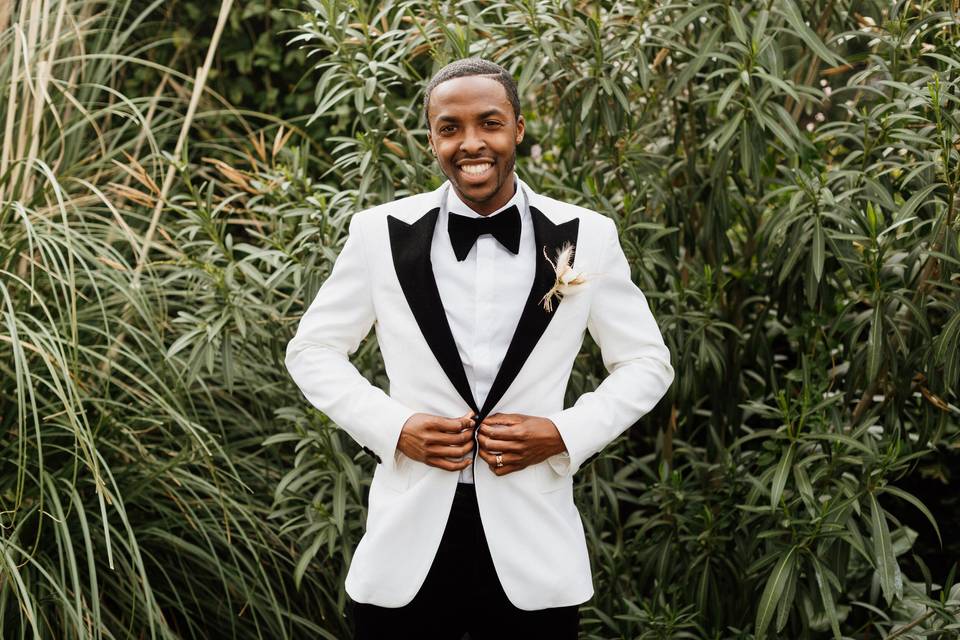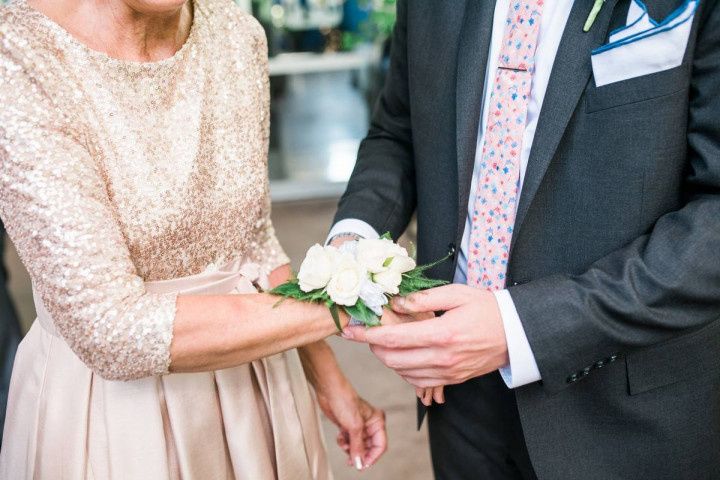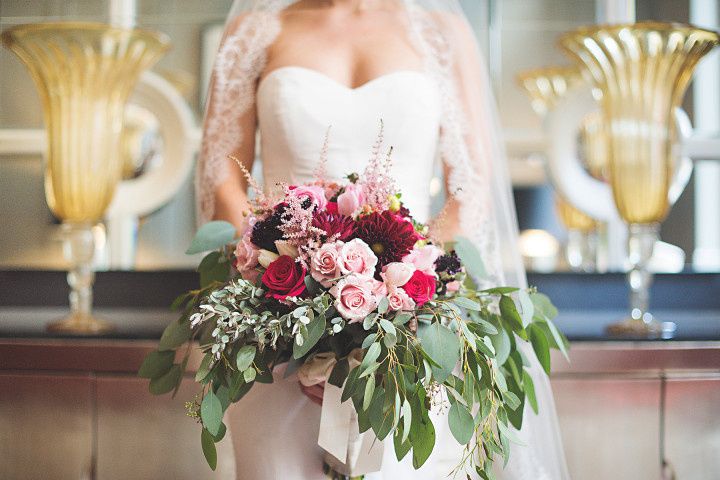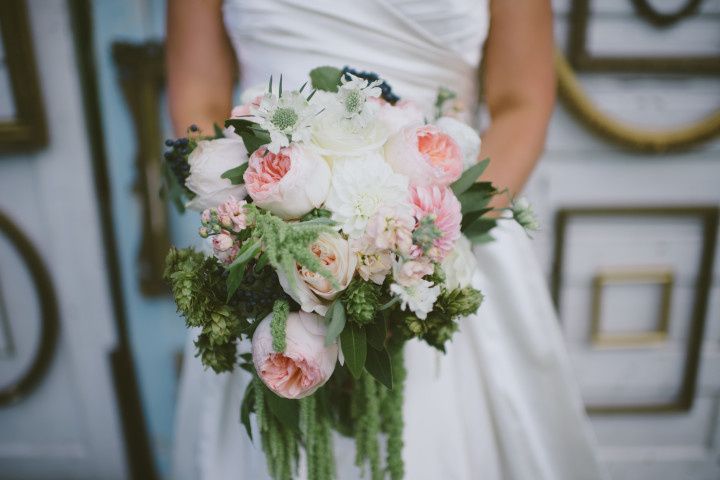Who Wears a Boutonniere at a Wedding?
Sporting a floral pin on your lapel is an honor—but who's actually supposed to wear a wedding boutonniere? Here's each and every person who needs one of these special accessories.
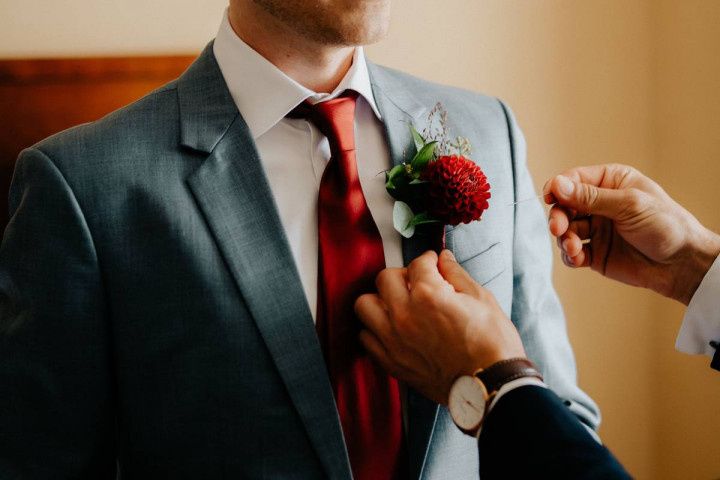
These small bunches of flowers are usually reserved for VIPs, but as you plan for your big day, you might find yourself asking: Who actually needs a wedding boutonniere? We’ve compiled a list of the most-likely candidates to receive boutonnieres, but we also recommend discussing this with your wedding florist to ensure you honor the right people—and that you stick to your allotted budget (depending on the style, boutonnieres can be time-consuming to make and pricey, so choose wisely!). Here are the basic details to know about wedding boutonnieres, including what they are, who wears them, how they should look, and more.
What is a wedding boutonniere?
A boutonniere is a single flower or a small cluster of flowers that is typically reserved for formal occasions, including weddings. Boutonnieres, which are also called “buttonholes” in some cultures/regions, are worn on the left lapel of a suit or tuxedo jacket, right over the heart. Traditionally, the flower stems would be placed through a small buttonhole on the lapel (hence the name), but now it’s common to fasten the wedding boutonniere using pins, since many modern jackets no longer include the buttonhole. Those who choose to skip the jacket can pin their boutonniere directly to a vest, dress shirt, or suspender instead.
How much does a wedding boutonniere cost?
The cost of a boutonniere is significantly less than the cost of a wedding bouquet or wedding centerpiece, but you’ll still want to factor it into your overall budget (FYI: most couples spend about eight percent of their total wedding budget on the flowers). Think about how many wedding boutonnieres you’ll need to order—more on that in a minute—and remember that some types of flowers will be more expensive than others. If you only need a handful of boutonnieres, you might consider splurging on statement blooms, such as exotic orchids or garden roses.
You’ll also want to factor in the cost of labor. If your wedding florist is creating a dozen boutonnieres, you can expect the overall price tag to be higher than it would be for just two or three. Each wedding boutonniere is also time consuming to make (on average about 20 minutes), since they are so intricate and small. Your florist will be able to determine the estimated labor cost depending on the types of boutonnieres you want and how many you’re ordering. Lastly, consider ordering a few “backup” boutonnieres to have on hand in case one starts to wilt or is accidentally damaged.
What kind of flowers do you use for a wedding boutonniere?
Traditionally, if your partner is carrying a bouquet, your boutonniere would include the same types of flowers, or at the very least, flowers of a similar style and color. Some flowers work better for boutonnieres than others (see these wedding boutonniere ideas for examples). Your wedding florist is the expert and will help you decide which types of flowers are best suited for your wedding season, style, and budget—but in general, it's best to stick to sturdier blossoms that can hold their shape all day without water, such as orchids, roses, ranunculus, or even succulents.
Who wears a wedding boutonniere?
Long story short: Members of the wedding party and immediate family who are wearing a suit or tuxedo should also wear a wedding boutonniere. Here are the specifics.
Groom(s)
When thinking about who wears a wedding boutonniere, the groom or grooms should be at the top of the list. The groom’s boutonniere may be different and perhaps more elaborate or intricate than the other boutonniere-wearers’ arrangements so that he can truly stand out from the crowd. While floral boutonnieres are most common for a groom, we’ve also seen more creative boutonnieres featuring Legos, golf tees, action figures, feathers, guitar picks, pinwheels, and more. This is a great way for a groom to show off his personality and interests.
It also should be noted that, traditionally, the groom pays for the men’s boutonnieres. However, if the bride’s family is paying for the florist’s services, they may choose to pay for all flower arrangements, including boutonnieres.
Groomsmen and bridesmen
The groomsmen and best man have important roles to play on the wedding day. A boutonniere is not only a colorful accessory, it’s also a lovely way for the groom to thank his best guys. The groomsmen’s boutonnieres should complement the wedding’s color scheme as well as the groomsmen’s attire, so be sure to give your florist an accurate count so that no one is left out. The best man may receive a boutonniere that's slightly different from the rest of the groomsmen to identify his extra-special job.
If your wedding party includes bridesmen (men who are on the bride’s side), they too should receive boutonnieres, perhaps featuring different colors or flowers than the groomsman’s boutonnieres. Groomswomen or groomsmaids may wear pin-on or wrist corsages, or carry their own bouquets.
Another important note: Be aware that pinning a boutonniere to a lapel can be tricky, so it might be worth asking your wedding party members to practice this task beforehand to minimize panic on the big day.
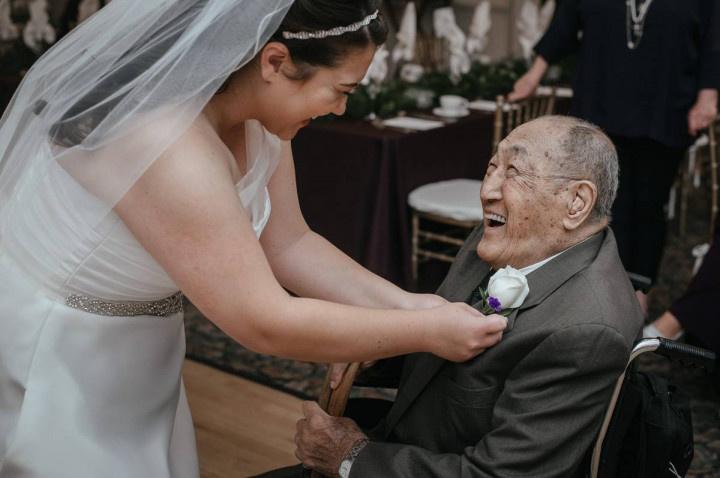
Fathers and stepfathers of the couple
When planning your list of wedding boutonniere recipients, don’t forget about dear ol’ dad! Fathers of the bride and groom, as well as stepfathers, should all be given boutonnieres to wear. Make sure that your wedding photographer and videographer are present when you present your father with his boutonniere, and help him fasten it to his lapel. Even the most serious of dads will get emotional during this special moment—and it’s always a sweet photo op!
Grandfathers of the couple
For those fortunate enough to have a grandfather or grandfathers attending their wedding, be sure to gift ‘em a boutonniere to show how grateful you are for their presence. Try to make the time to give your grandpa his boutonniere in person—he’s sure to be delighted by this special accessory.
Ring bearer
Your littlest attendant shouldn’t be forgotten among those who will receive a boutonniere to wear on the big day. The ring bearers’ boutonniere should be scaled-down versions of the groom’s or groomsmen’s boutonnieres so he’ll fit right in with the rest of the wedding party.
Ushers
While ushers aren’t technically part of the wedding party, they still have an essential role to play. Boutonnieres are not only pretty to look at, they’ll also identify your ushers as point people for guests with seating questions or special needs. If possible, your ushers’ boutonnieres should vary (even slightly) from those your groomsmen are sporting.
Officiant
Your wedding officiant may also wear a boutonniere. If your officiant is not a religious official and will be wearing secular attire like a suit, he should be given a boutonniere. However, certain religious officiants wearing traditional dress may not wish to wear a boutonniere, so you might ask for his preference.
Other immediate family members and VIPs
Lastly, wedding boutonnieres may be worn by anyone who you and your future spouse feel deserve a little extra love. This can include ceremony readers, other immediate family members who may not be in the wedding party, and more. Work with your wedding florist to determine proper wedding boutonniere etiquette for your specific event and budget.

